Byzantine and Modern Greek Studies, volume 48, issue 12 (October 2024).
CONTENTS INCLUDE
Remarks on the collection of Byzantine lead seals of the Barber Institute of Fine Arts (University of Birmingham): mobility, networks, and identity in eastern Pontos
Christos Malatras
The Byzantine lead seals of the Barber Institute of Fine Arts number in total 146 pieces, mostly collected in the region of Trebizond. They offer valuable insights into the middle Byzantine society of the Pontos region, which despite its location on the easternmost borders was connected with other, even more remote, regions of the empire. The majority of these seals come from local officials and reflect their local preoccupations, perhaps as a backlash to the dominant culture of the capital. Fifteen selected pieces from the collection are published here and provided with commentary.
The semantron to Western ears: othering through sound
Alex Rodriguez Suarez
For centuries Eastern Churches only employed the semantron, usually an elongated piece of wood that is struck with a hammer, to gather the faithful. Eventually, most adopted bell ringing, even though semantra continue to be used by some Orthodox Churches. In the West bells were rung for the same purpose and the semantron was unknown. As a result, Western pilgrims, diplomats, and other travellers to the eastern Mediterranean were astonished and intrigued when they encountered the instrument. This article looks at their descriptions and discusses how the instrument and its sounds were used to other Oriental Christianity.
Marriage, comedy, and the patristic tradition in the first Ptochoprodromic poem
Konstantinos Chryssogelos
The present paper deals with the first Ptochoprodromic poem's treatment of the early patristic tradition. Its focus is on the conjugal life of the Ptochoprodromic couple, whose interaction is compared to the precepts of the Byzantine Fathers on the ideal Christian marital life. Evidently, the poet parodies the tradition to which the said precepts belong, offering a comic image of the ideal Christian couple in which gender roles have been reversed. Moreover, the final scene of the poem, where the husband disguises himself, is linked to the hagiographical tradition of cross-dressing women, as well as of male saints in disguise.
Founding fathers of Greek history-writing in early modern Constantinople
Ioannis Kyriakantonakis
A crucial aspect of the intellectual field shaped by religious relations and conflicts following the Reformation was the domain of historiography, which involved the writing of works that aimed at edification and at the support of the doctrinal stances of opposing ideological factions. This article examines the positioning of early modern Orthodox reflections on the past. The scholars under consideration were the first Greek-speaking writers of early modern times to delve into the uses of historical documentation and raise inquiries concerning the nature and methodology of historical knowledge. The ‘idea of history’ built on the vita activa of key actors of the Orthodox community in the Ottoman Empire, contributing to discussions on identity in a world of competing empires and churches.
Select Fragments from Ottoman Zagori: continuity and change in a montane landscape through a local perspective
Faidon Moudopoulos-Athanasiou and Elias Kolovos
This article discusses elite continuity and settlement pattern change in Zagori (NW Greece) from the late fourteenth to the nineteenth century. The peaceful assimilation of the regional and local elites into the Ottoman Empire (1430) led to adaptations in the montane landscape. Imperial and local archival research, ethnography, and landscape archaeology reveal that the Ottoman administration divided large decentralized settlements into smaller villages to accommodate local elites and new timariots. This topography of division (fifteenth to sixteenth centuries) gave way to a topography of adaptation (seventeenth to nineteenth centuries) when local elites influenced settlement patterns in forming the administrative unit the Zagorisian League.
Reviews
Petros Bouras-Vallianatos, Innovation in Byzantine Medicine. The Writings of John Aktouarios (c. 1275-x. 1330). Oxford: Oxford University Press 2020.
Barbara Zipser
Nathanael Aschenbrenner and Jake Ransohoff (eds), The Invention of Byzantium in Early Modern Europe. Washington, DC, Dumbarton Oaks Research Library and Collection 2021.
Matthew Kinloch
